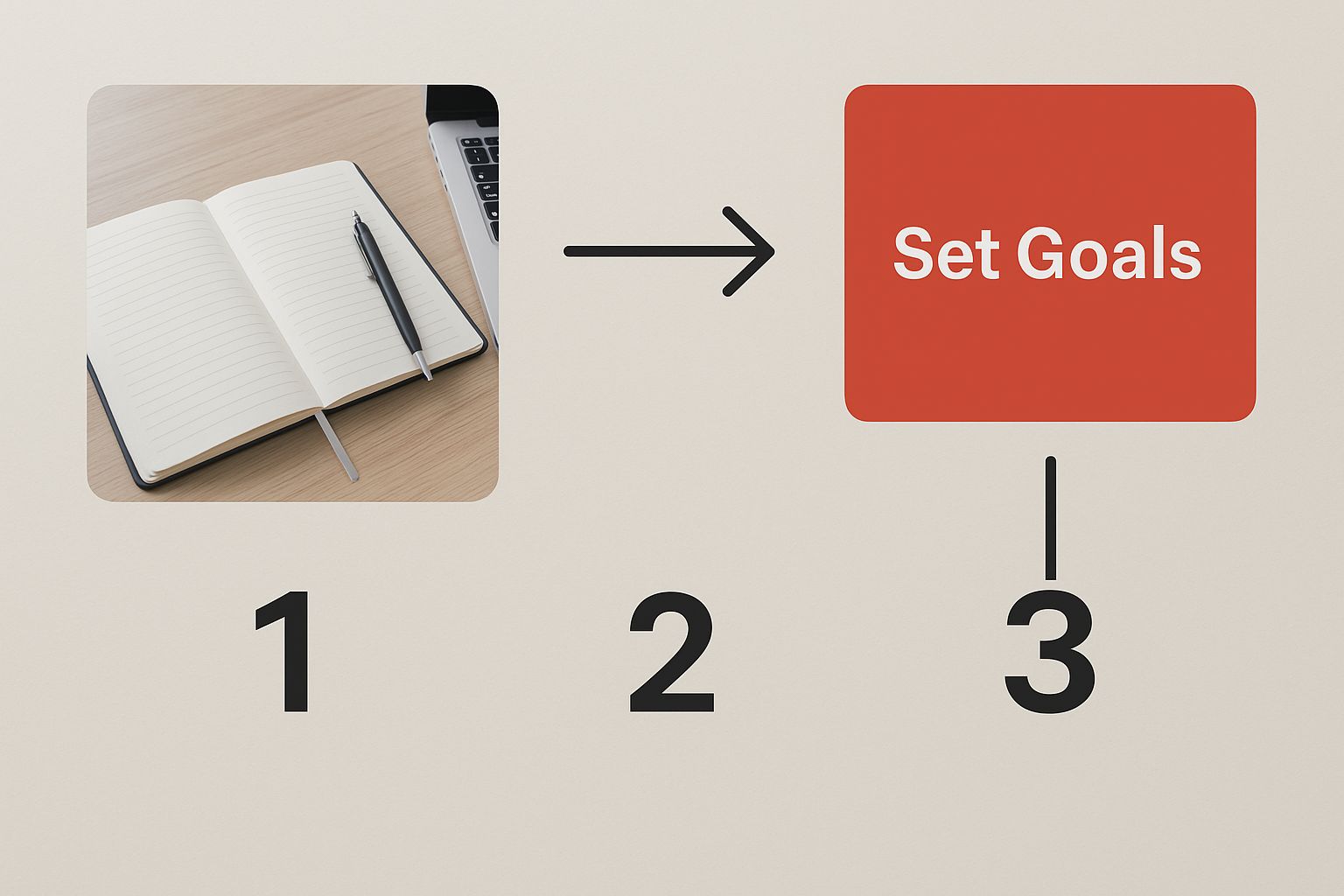Beyond the Basics: What Marketing ROI Really Means
Let's be real, "marketing ROI" can sound like a bunch of mumbo-jumbo. Terms like "attribution models" and "customer lifetime value" get thrown around, and it's easy to feel lost. But after talking with tons of marketers who've dealt with budget cuts and demanding bosses, I've noticed something important: many are measuring the wrong things.
Measuring ROI isn't about blindly plugging numbers into a formula. It's about setting the stage for every marketing decision your company makes down the line. Think of it like building a house. You wouldn't start with the roof, right? You need a solid foundation first. Your ROI measurement needs that same strong base to give you accurate and useful insights.
This means understanding that some traditional metrics can be deceiving. Lots of website visits might seem great, but if those visitors aren't turning into leads or sales, it's just a vanity metric. Smart marketers know the difference between vanity metrics and the ones that actually show business impact. They concentrate on the metrics that line up with their big-picture business goals. You might find this interesting: Check out our guide on: measuring brand awareness.
Speaking of business impact, proving marketing ROI has become a much bigger deal lately. With more pressure on marketing budgets, it makes sense. In fact, by 2024, showing ROI was a top priority for 83% of marketing leaders, up from 68% just five years earlier. This focus on ROI affects how budgets are spent, with 64% of companies now basing future marketing budgets on past ROI performance. But even with all this emphasis, only 36% of marketers feel confident they can accurately measure ROI, which shows how tough it is to track results across different channels. Discover more insights about marketing ROI statistics.
This difference between how important ROI is and how hard it is to measure it points to a key challenge: more data doesn't automatically mean better understanding. What separates successful companies from the rest isn't how much data they gather, but how they use it. This means going beyond the surface-level numbers to figure out what's really driving marketing performance. It's about asking not just "what happened?" but "why?" and, even more importantly, "what should we do next?" This strategic way of looking at ROI is what changes marketing from a cost center into a revenue driver.
Building Your ROI Measurement Foundation That Actually Works
Let's be honest, measuring marketing ROI can be tricky. Many marketers jump straight into complex calculations without a solid plan. It's like building a house without a blueprint – you might end up with something, but it probably won't be structurally sound. I've seen this happen time and again: companies with well-defined measurement systems, built to withstand budget cuts and leadership changes, consistently outperform those relying on haphazard calculations.
So, how do you build a strong foundation? It all begins with defining conversions. What actions truly drive your business forward? A demo request? A purchase? A newsletter signup? For a SaaS company, a free trial might be the golden ticket, while an e-commerce store thrives on completed purchases. This clarity helps you cut through the clutter and concentrate on what truly matters.
Then, there's the attribution window to consider. This is the timeframe you use to link marketing activities to conversions. If your typical sales cycle is 60 days, using a 30-day window will drastically undervalue your marketing's contribution. I remember working with a client with a long sales cycle. Simply adjusting their attribution window revealed that their content marketing efforts were generating significantly more value than they initially thought.

The image above illustrates the vital first step: setting clear goals for your ROI framework. Like any project, well-defined goals are essential for focusing your efforts and tracking progress toward what counts. Without this initial step, your measurement efforts risk becoming fragmented and ineffective. Learn more in our article about promotional product pricing and smart ROI strategies.
Aligning Your Measurement With Stakeholder Expectations
Getting everyone on the same page is crucial. Your CFO and CMO will be interested in different aspects of your marketing performance. The CFO cares about the bottom line—how much revenue did marketing bring in? The CMO, on the other hand, wants to know which campaigns are driving engagement and building brand awareness. Finding the sweet spot between these perspectives is essential.
Setting Realistic Benchmarks
Don't fall into the trap of chasing arbitrary industry averages. While they can offer a point of reference, focus on your progress and identify opportunities for improvement. If your conversion rate is currently 2%, set a realistic goal to boost it to 2.5% next quarter. These incremental gains accumulate over time and lead to significant results.
Building a Flexible Framework
The business world is constantly evolving, and your measurement approach needs to keep pace. What worked last year might not be effective today. Regularly review your chosen metrics, adjust your attribution windows as needed, and refine your conversion definitions.
Before we move on, let's take a look at the key components of a successful ROI measurement framework. The table below outlines the essential elements, their purpose, implementation priority, and common challenges you might encounter.
Marketing ROI Measurement Framework Components
| Component | Purpose | Implementation Priority | Common Challenges |
|---|---|---|---|
| Conversion Definitions | Clearly define what actions constitute a successful outcome. | High | Ensuring alignment across teams on which conversions truly matter. |
| Attribution Window | Determine the timeframe for connecting marketing efforts to conversions. | High | Selecting an appropriate window that accurately reflects the sales cycle. |
| Stakeholder Alignment | Ensure that the measurement approach meets the needs of different stakeholders (e.g., CFO, CMO). | High | Balancing financial metrics with marketing performance indicators. |
| Benchmarking & Goals | Establish realistic benchmarks and set achievable goals for improvement. | Medium | Avoiding the trap of chasing arbitrary industry averages. |
| Data Collection & Analysis | Implement tools and processes to gather and analyze relevant data. | Medium | Integrating data from various sources and ensuring data accuracy. |
| Reporting & Review | Regularly review metrics, adjust strategies, and communicate results to stakeholders. | Medium | Creating clear and concise reports that provide actionable insights. |
This table provides a roadmap for building a robust and adaptable measurement system. By addressing these key components, you'll be well on your way to accurately assessing your marketing impact.
By concentrating on these core principles, you’ll create a measurement system that not only accurately reflects your marketing impact but also informs future strategies. It’s about establishing a solid foundation that supports your entire marketing operation, from brand-building campaigns to direct response initiatives.
The Math That Matters: ROI Calculations That Tell the Truth
Calculating your marketing ROI isn't about blindly plugging numbers into a formula. It's about understanding the nuances and getting the real story behind your data. Let's ditch the oversimplified approach and dive into how to measure ROI in a way that actually reflects the complexities of today's customer journeys.
Beyond the Basic Formula: Calculating ROI for Different Scenarios
Sure, the basic ROI formula is (Return - Investment) / Investment x 100. Spend $1,000, make $5,000, and bam—400% ROI. Looks great on paper, right? But in reality, it's rarely that straightforward.
Think about it. Imagine a SaaS company with a longer sales cycle. A potential customer might read your blog, download a whitepaper, attend a webinar, and then finally request a demo before purchasing. If you only give credit to that last touchpoint (the demo request), you're missing the bigger picture. You're ignoring the impact of all those other marketing activities. This is where understanding multi-touch attribution is key.
There are several ways to approach this. A linear attribution model spreads the credit evenly across every touchpoint. A time decay model gives more weight to interactions that happen closer to the actual conversion. And you can even build custom attribution models specifically designed to match your unique customer journey.
Now, contrast that with an e-commerce business running a flash sale. The sales cycle is much shorter, and you can more easily connect the dots between specific campaigns and the sales they generate.
The image below shows how Google Ads calculates conversions and cost per conversion, which are essential pieces of the ROI puzzle. It highlights how powerful these platforms can be for tracking and analyzing your data.

This screenshot provides a detailed view of conversions and costs within a Google Ads campaign. By digging into this data, you can see which ad groups and keywords are truly driving results. This granular level of insight is invaluable for optimizing your campaigns and boosting your ROI.
Handling the Tricky Stuff: Negative ROI, Seasonality, and Data Presentation
Let's be honest, not every campaign is a home run. Sometimes you'll see a negative ROI. But don't freak out. A negative ROI doesn’t automatically mean failure. It might just mean a campaign needs some adjustments. Or maybe it was a strategic investment in long-term brand building. I've seen campaigns with an initial negative ROI that eventually led to massive brand awareness and a huge sales boost months down the line.
Seasonality can also throw a wrench into your ROI calculations. If your business has predictable ups and downs throughout the year, compare your performance to the same period in previous years, not just month-over-month.
And finally, how you present your data is crucial. CFOs want the bottom line. CMOs want campaign performance insights. Tailor your reports accordingly. Use clear visuals and focus on actionable takeaways. Don't just report on what happened—show how your ROI analysis will shape future decisions.
From Calculations to Optimization: Using ROI to Drive Better Results
Calculating ROI isn't a one-time thing; it's an ongoing process of improvement. Use your data to spot high-performing campaigns and channels, shift budgets strategically, and experiment with new approaches. Metrics like customer lifetime value (CLTV) are invaluable for understanding the long-term impact of your marketing efforts.
By looking at CLTV alongside customer acquisition cost (CAC), you can make smart, data-driven decisions that maximize profitability. For example, if a particular channel has a high CAC but also delivers customers with high LTV, it might be worth sticking with it despite those higher upfront costs.
This constant optimization is what separates good marketing from great marketing. It's all about using data to refine your strategies, get the most out of your budget, and drive real, sustainable growth.
Mastering Multi-Channel ROI in a Connected World
Let's be honest, nobody shops in neat little boxes. Your customers experience your brand across everything – social media, email, websites, even walking into your store. So why measure your marketing ROI like they do? Traditional channel-specific measurement just doesn't cut it anymore. It misses the bigger picture of how these channels work together.
Think about a typical customer journey. Maybe they see your ad on Instagram, then search for you on Google a week later. Maybe they sign up for your emails and finally buy something after clicking a link in your newsletter. Which channel gets the credit? It's almost never a simple, single-touch attribution.
This interconnected customer journey needs a smarter approach to measuring marketing ROI. It's about understanding the whole customer lifecycle and how each channel contributes – not just who gets the final click. Think about brand awareness campaigns. They're tough to directly link to sales, but they can have a huge impact on later conversions. Even something like a well-placed billboard can surprisingly boost online sales.
Measuring ROI takes a holistic view, looking at multiple channels and different metrics. Many marketers focus on digital channels like email and social media. But a truly comprehensive ROI strategy brings together both digital and traditional marketing. Surprisingly, only about one-third of marketers globally are measuring both together. Learn more about maximizing ROI in a fragmented market here.
Bridging the Online-Offline Divide
Here's another big challenge: tracking offline conversions. Analytics platforms are great at capturing online interactions, but they often miss crucial offline touchpoints. Someone sees your TV commercial and then visits your store to buy something – how do you connect those dots?
Smart marketers are finding creative solutions. They use unique promo codes for different campaigns, track phone calls from specific marketing materials, and even use in-store surveys to tie online and offline activity together. A dedicated tool like a Social Media ROI Calculator can also help you quantify your social media efforts.
Building Your Multi-Channel Attribution Model
The secret to multi-channel ROI? Building an attribution model that actually reflects your customer journey. There's no magic bullet or one-size-fits-all answer. A linear attribution model, where credit is split evenly across all touchpoints, might work for some. Others might see better results with a time decay model, giving more weight to touchpoints closer to the conversion.
The most sophisticated approach? A custom attribution model. This takes a deep dive into your customer data and careful thought about each channel's role in your overall marketing. It's about understanding that complex web of interactions and giving credit where it’s due. This helps you see the real influence of each touchpoint, find the channels that work best together, and optimize your marketing mix for maximum impact.
ROI Measurement Tools: What Actually Delivers Value

This screenshot shows a typical Google Analytics dashboard. It gives you a snapshot of website traffic and user behavior, and even this readily-available tool offers valuable data for figuring out your marketing ROI. Notice those key metrics like user acquisition, engagement, and conversions? Those are gold for understanding how well your campaigns are actually performing.
So, let’s talk tools. There are tons of marketing technology options out there, but how do you pick the right one? It's easy to get distracted by shiny new platforms, but the best tools are the ones that give you real value without breaking the bank. I've seen companies spend a fortune on enterprise solutions, only to realize they weren't even using half the features. It's like buying a Ferrari to drive to the grocery store – impressive, but is it practical?
Finding the Right Fit: Tools for Different Needs
The key is finding tools that match your business needs and how complex your setup is – from simple website analytics to sophisticated attribution platforms. If you're a small startup, Google Analytics might be all you need to get going. It offers a ton of data on website traffic, user behavior, and conversions. You can see which campaigns are bringing in traffic, find your high-performing content, and even set up conversion goals to measure specific actions, like demo requests or purchases.
For more advanced tracking across different channels, consider platforms like HubSpot or Mixpanel. These tools offer deeper insights into customer journeys, multi-touch attribution, and how well your campaigns are performing overall.
Integrating Your Measurement Stack
As your business grows and your marketing gets more complex, you’ll probably need more specialized tools. Enterprise-level attribution solutions like Bizible (now part of Marketo Engage) or Ruler Analytics can help you understand those complicated customer journeys across multiple channels, both online and offline. They let you build custom attribution models that reflect your business model, giving you a more accurate view of how each touchpoint contributes to conversions. For optimizing multi-channel ROI, look into tools like social media automation tools.
Don’t underestimate how important it is to integrate all your measurement tools. Data silos are a ROI-killer. If your CRM, marketing automation platform, and analytics tools aren’t communicating, you’re missing out on valuable insights. Integrating these tools can be tricky, but it's essential for getting a complete picture of your marketing performance.
The Hidden Costs of Technology
Here's the thing: technology is only one piece of the puzzle. Even the best tools won't help if you don't have the right people and processes in place to use them effectively. I’ve seen so many companies overspend on technology and underspend on training and implementation. It’s like buying a professional camera and only using auto mode.
Before you spend a ton of money on a new platform, really look at the tools you already have. Are you using them to their full potential? Are there ways to use existing features to get the data you need without adding another subscription? You can often significantly improve your ROI measurement just by getting more out of what you already have. A better strategy might be to build your measurement stack gradually, focusing on the most impactful tools first, rather than jumping in headfirst. Remember, measuring marketing ROI isn't about having the most data; it's about having the right data and using it to make smart decisions.
Here's a comparison of some popular ROI measurement tools to help you get started:
Marketing ROI Measurement Tools Comparison Popular ROI measurement tools with features, pricing, and best use cases
| Tool | Best For | Key Features | Pricing Range | Integration Level |
|---|---|---|---|---|
| Google Analytics | Small businesses, basic website analytics | Website traffic, user behavior, conversions, goal tracking | Free | Basic |
| HubSpot | Mid-sized businesses, integrated marketing | CRM, marketing automation, email marketing, analytics | Varies by plan | High |
| Mixpanel | Product analytics, user engagement | In-app event tracking, cohort analysis, A/B testing | Varies by usage | Medium |
| Marketo Engage (Bizible) | Enterprise businesses, multi-touch attribution | Advanced attribution modeling, custom reporting, CRM integration | Custom pricing | High |
| Ruler Analytics | Marketing attribution, lead tracking | Call tracking, form tracking, offline conversion tracking | Varies by plan | High |
This table gives a quick overview of some of the most common tools available. As you can see, they vary in features, pricing, and how easily they integrate with other platforms. Choosing the right combination for your business is key.
Turning ROI Insights Into Marketing Optimization Wins
Measuring marketing ROI isn't just about generating reports. It's about using that data to make your marketing smarter and more effective. Think of it as a GPS for your marketing strategy, guiding you towards better decisions and bigger results. After all, what's the point of collecting all that data if you aren't going to use it?
From Data to Decisions: Optimizing Your Marketing Mix
Savvy marketers use ROI data to fine-tune their entire marketing mix. Let's say you're running campaigns across Google Ads, social media, and email. Your ROI analysis reveals email delivers a 10:1 return, while social media lags at 3:1. This doesn't automatically mean abandoning social media. It does mean taking a closer look at your social media strategy, identifying areas for improvement, and perhaps shifting some budget towards email to maximize your overall return. To make informed decisions – not just impulsive reactions – be sure you have the proper measurement tools. A good starting point might be checking out this article on measuring the success of your sales automation strategy.
A/B Testing for ROI: Finding What Really Works
A/B testing is incredibly powerful for optimizing marketing ROI. I once worked with a client who had two versions of a landing page. One featured a video, the other just text and images. We tracked the ROI of each and found the video version generated a 20% higher conversion rate. That small difference added up to a significant ROI boost over time. This kind of testing goes beyond tweaking headlines or button colors. It's about finding what genuinely connects with your audience and drives real business results.
Identifying Hidden Opportunities: Digging Deeper Into Your Data
Sometimes, the best insights are hidden in plain sight. Go beyond the surface numbers and dig into your data. You might discover a particular audience segment is much more receptive to specific content or a particular channel. I once noticed a client's blog posts about a niche topic were driving surprising traffic and conversions. We doubled down on that topic, creating more content and promoting it heavily. The result? A measurable ROI lift. For more on maximizing your impact, you might find this interesting: Boost your brand awareness measurement for better ROI. These "hidden gems" can be real game-changers.
Building Feedback Loops: Continuous Improvement
The most effective marketing strategies are built on feedback loops. This means continually monitoring your ROI, adjusting based on the data, and tracking the impact of those changes. It's a cycle of constant improvement. If you notice a dip in ROI for a particular campaign, don’t panic. Analyze the data, identify potential reasons, tweak your approach, and observe the results. Maybe your audience has shifted, your messaging is off, or your targeting needs adjustment. The key is to be proactive and data-driven.
Communicating ROI: Turning Insights into Action
Finally, remember ROI measurement isn't just for you. It’s crucial for getting buy-in from stakeholders and proving the value of your marketing efforts. When you can clearly connect your marketing activities to revenue growth, you're in a much stronger position to advocate for resources and implement new strategies. Don’t just present data—tell a story. Show how your ROI insights drive real business impact. This transforms measurement data into a competitive edge, strengthening your position and fueling future growth.
Your ROI Measurement Action Plan: From Theory to Results
So, we've covered the basics of measuring ROI in marketing. Now, let's talk about how to actually use this stuff. Forget complicated spreadsheets and endless data crunching. This is about building a system that gives you the insights you need to make smarter decisions. By the way, if you're looking for more growth strategies, check out our guide on startup marketing strategies for rapid growth.
Prioritizing Your Measurement Efforts
Not all improvements are equal. Some tweaks will have a much bigger impact on your bottom line than others. Focus on the low-hanging fruit – the areas where you can see quick wins. If attribution is a struggle, start there. If your conversion tracking is messy, clean that up first. It's about picking your battles and building momentum.
Getting Buy-In From Stakeholders
Let’s face it, getting everyone on board with ROI measurement can be tough, especially if they're used to vanity metrics. The trick is to speak their language. Show them how better measurement translates into better results. Use real-world examples. If you can show how a small change to your attribution model resulted in a 10% increase in conversions, you'll have their attention.
Building ROI Measurement Into Your Operations
This isn't a one-and-done project. It's an ongoing process. Make ROI measurement part of your regular marketing workflow. Schedule reviews of your key metrics, analyze what's working and what's not, and adjust your strategies. Think of it like checking the oil in your car – a small, regular effort that prevents major problems down the line.
Troubleshooting and Template Frameworks
There will be roadblocks. That's just part of the process. Having a plan for common implementation challenges can save you tons of headaches. Consider building adaptable template frameworks that work for different business models. This will make it easier to track progress, spot potential problems, and make adjustments as you go.
Success Metrics: Measuring What Matters
It’s easy to get overwhelmed with data. Focus on the metrics that actually reflect the value of your ROI measurement system. Are you making better decisions? Are you optimizing your campaigns more effectively? Are you getting more from your marketing budget? Those are the important questions. I've seen companies with complex measurement systems that collect tons of data but don't do anything with it. It’s like having a fancy kitchen and never cooking a meal.
Maintaining Momentum and Avoiding Pitfalls
Implementing a new system is exciting at first, but it's easy to lose steam. Set realistic goals, celebrate small victories, and keep your team focused on the big picture. Learn from others who have successfully transformed their measurement approach. What worked for them? What challenges did they encounter? Learning from their experience can help you stay on track and avoid common pitfalls.
Ready to take your brand to the next level with custom electronics? Explore the possibilities with Electronic Finishing Solutions today.



